Исследование якутского кинодискурса через анализ кинорецензий
Aннотация
Данное исследование посвящено изучению якутского кинодискурса через анализ кинорецензий как вторичных текстов. Целью исследования является определение главных тем якутского кинодискурса и эмоций, которые передаются фильмами и отражаются в рецензиях. Материалом анализа послужили 72 рецензии на пять якутских фильмов, выпущенных в 2016-2020 гг. Выбор фильмов обусловлен такими факторами, как дата выпуска, жанровая принадлежность, известность, количество доступных рецензий. Рассматриваемые кинорецензии были написаны как критиками, так и обычными зрителями. Исследование основывается на контент и сентимент анализе, проведённом посредством компьютерных программ. Результаты исследования показывают, что основными темами якутского кинодискурса являются: повседневная жизнь якутского народа, природа республики, провинциальное сообщество, социальные проблемы, семейные отношения, судьба. Якутский кинодискурс изображает мрачную жизнь полную трудностей и несправедливости в суровых климатических условиях. Сентименты, передаваемые проанализированными кинорецензиями, а также всем кинодискурсом, преимущественно негативные. Результаты исследования свидетельствует о возможности изучения определённого кинодискурса через вторичные тексты и дискурсы, чтобы установить их специфические характеристики. Кинорецензии способны интерпретировать и всесторонне репрезентировать кинодискурс.
К сожалению, текст статьи доступен только на Английском
Introduction
Film production resulted in emergence of some textual genres that nowadays are considered to be media phenomena. Film review as an independent genre appeared in 1907 when the first text of that kind was published in the American weekly magazine “Variety”. As cinematography was evolving during the 20th century, film review was gaining popularity (Anikiev, 2018). Early movie reviews mainly discussed and criticized acting, decorations, and camera work. The number of issues highlighted in that type of text gradually increased. Thus, film reviews proceeded to cover multiple things that fall into two broad categories: formal techniques and thematic content. Formal techniques include genre, narrative, mise-en-scene, lighting, editing, music, diegetic / non-diegetic sounds while thematic content refers to the plot, topical issues raised in a film, e.g. historical, gender, racial, etc. Khotnog points out that the reviewers’ communicative goals differ accordingly. If they write about the items of the first group then their aim is to evaluate the aesthetic features of a film. In contrast, if reviewers opt for commenting items of the second group, they attempt to provide their readers with some information about the film plot in an accessible and interesting form. Hence, we see different perspectives to present critical overview: aesthetic perspective and social perspective. Social is typical for general-oriented items, i.e. an appeal to topical issues of life of a particular society whereas aesthetic is primarily important for cultural aspects (Khotnog, 2020).
Apart from professional critics, movie experts, filmmakers, and journalists, ordinary viewers started writing film reviews in the 1990s. It happened due to, first of all, accessibility of films on DVDs and the Internet and, secondly, because of human nature that makes us stay subjective about everything we perceive, e.g. services, goods, works of art, etc. It is no wonder that analysis and evaluation of acting, directing, camera work, screenwriter’s work became optional elements of a modern film review. As a result, Nabieva argues that retelling of the plot takes up most part of the film review (Nabieva, 2016).
Researchers offer various definitions of “film review” which vary mostly depending on the objectives of their studies. The term “film review” refers to an article that states its writer’s opinion about a specific movie and criticizes it positively or negatively. The article helps readers understand the idea of the film and decide whether to watch it or not. Baksheeva and Gorshkova claim that being one of the genres of criticism, film review is a secondary text which belongs to the analytical group of genres. Analytical genres include analysis and evaluation of a film (Baksheeva, Gorshkova, 2019). Over the years an array of studies to determine the extent to which movie criticism influences film perception has been carried out (Terry, Butler, De’Armond, 2004). The majority of these papers has proved that film criticism historically had a great impact on the film success as it may reassure people to watch it, and vice versa - encourage them to do it (Eagan, 2018). Along with it, film criticism forms viewers’ expectations, influence their perception and interpretation. Consequently, readers can evaluate a film being guided by critics’ perception. Hence, the underlying feature of film review is its multifunctionality since it performs a number of functions, e.g. informative, critical (or evaluative), motivating, advertising, entertaining, etc. (Stegert, 1993). Although, the role of film critics may be debatable, we cannot deny functional power that film review possesses.
The compositional and structural organization of film reviews is variable. The structure of this type of text may depend on the author’s intentions, the format of a publication (i.e. online, print), and its features. Researchers often distinguish two blocks in the structure of film reviews which can be classified as “descriptive” and “evaluative” or “illustrative” and “constructive” (Zemtsova, 2006). The first block contains the elements of the film (the content, setting, characters, etc.) while the second block is the core of any review and represents the reviewer’s judgments and comments that support his/her point of view. In addition, the compositional and structural organization of this text genre may include visual elements, for instance, trailers, film stills, posters. Going into specifics, composition of a common well-structured film review may consist of the following parts: introduction, plot summary, analysis of the key events, characteristic of characters and their interactions, reviewer’s opinion, and conclusion.
M. Hoffmann notes that the important feature of film review is recoding signs either within one sign system or from one into another. It means that oral dialogues are transformed into written monologues while pictures and sounds are verbalized into a reviewer’s text (Hoffmann, 1995). Therefore, film review is a product of the processing and verbalization of film text. Erman and Ermakova argue if we understand R. Barth’ words about the review as a “secondary language” then any review is a discourse about the discourse (Erman, Ermakova, 2018). None of the discourses exists independently; any discourse refines other discourse and at the same time becomes a source for new discourse (Pescheux, 1999). Text is a necessary component of discourse, which is a cognitive and informative event, and its manifestation - information trail (Susov, 2007). As Fomina states, film review as a secondary speech genre can serve as a good example of the intersection and interaction of discourse (Fomina, 2011). The reviewer’s discourse and film discourse interact closely at the level of the reviewer’s presentation of the film text. It means that film is presented through the reviewer’s perspective as the author comments on particular scenes and stills from the film, demonstrates their attitude to the story, plot development, evaluate the film. In addition, film review may also include parts of other discourse, e.g. discourse of a screenwriter, director, other films, critics’/ directors’/ viewers’ opinions, etc., as well as numerous cognitive elements that fall outside of the scope of film discourse (Mitryukhina, 2016).
Statement of the problem and dataset
In today’s world which is all made up of globalized phenomena in culture, art, and in cinema, whose language is not similar to any others’, ethnic cinema becomes very rare and of great value. Ethnic cinema is filmed in a native language, for a national audience, it is based on the archetypes of traditional culture, in whatever genre the motion picture is, e.g. comedy, horror, romance. The cinema of the Sakha Republic (Yakutia) is a unique example of a systemically functioning local film production whose equivalents are not easy to find. On the one hand, we may draw a parallel between Yakut films and blaxploitation movies. Blaxploitation is an ethnic subgenre of American exploitation films about African Americans who are at the same time the target audience of these films. On the other hand, it will be more accurate if we compare it with the cinema of the Inuit of Canada or the Sinitic speaking minority of Malaysia.
Yakutia has its own culture, language, traditions, mythology, religion that are unlike any others in Russia. It is worth mentioning that although being influenced by the Russian language and culture, the region managed to preserve its national language and ethnic culture. After all, it is too remote, big, cold, and special. Due to these reasons, the Yakuts have a rather apathetic attitude towards globalized cinema that we all watch. Therefore, the demand for national films is higher than for Hollywood or Russian blockbusters there.
Although movies, mostly about life of hunters and the establishment of Soviet power, were produced in Yakutia during the Soviet era, Yakut film industry has been experiencing a period of growth over the recent years. Since the release of the drama “My Love” (2004) directed by S. Potapov, which resembles South Korean thrillers, films of diverse genres (e.g. drama, comedy, horror, etc.) have been annually produced in Yakutia. The climax seems to be reached in 2020 when the Yakut film “Scarecrow” directed by D. Davydov was selected to participate for the first time in history in the Russian Film Festival “Kinotavr” and, moreover, won the grand prize.
According to Iampolski, film like any other work of art does not have an ability of self-interpretation therefore needs a metadiscourse supplied by criticism[1]. Cinematic language operates with themes, complex of images, various issues, which allow journalists / critics / viewers to observe how film reflects the world, people build relations, what human nature is like, as well as to highlight and interpret underlying meanings in a film that characterize the current state of society. Therefore, reviews for feature films have become a means of discussion of social issues and analysis of social processes (Hegai, 2019).
In the current study we make an attempt to analyze film reviews for modern Yakut films in order to discover main themes, issues, images of the Yakuts and their region shown in ethnic cinematic discourse. Emotions and tones conveyed by films are also of particular interest to us. Thus, the main aim of this research is to implement content analysis of film reviews and identify their underlying sentiment so as to learn about Yakut cinematic discourse through the film reviews.
The material of the research is 72 reviews for five Yakut films released between 2016-2020. The criteria for choosing films are time of release, genre affiliation, popularity, number of available reviews. It is worth mentioning that the reviews are written by both critics and common viewers. Users’ reviews were retrieved from Kinopoisk[2], Russian most popular content source for films, and critics’ reviews were taken from different Russian magazines and newspapers (Gazeta.ru[3], Fontanka[4], Kinoart[5], Kino-teatr.ru[6], GQ[7], Kinoafisha[8], InterMedia[9], Buro 24/7[10], Expert[11], Trud[12], Time Out[13], Meduza[14], Echo of Moscow[15]).
Research methods
To identify the main themes of Yakut cinematic discourse in this study we apply one of the most effective methods of text research – content analysis. Content analysis is a formalized methodology for the study of texts and graphic information that involves transformation of the analyzed data into quantitative form and its statistical processing. The object of content analysis can be the content of various printed materials, radio and television programs, films, advertisement, documents, public speeches, questionnaires[16]. According to Pashinyan, content analysis involves the conversion of verbal information into objective non-verbal (digital, quantitatively processed) data whose interpretation allows a researcher to go beyond the text itself and make conclusions about social aspects of the surrounding reality (Pashinyan, 2012). Neuman suggests using the method to analyze large text arrays to determine various structural-linguistic properties (e.g. key words, main structural components, frequency of semantic categories, etc.) (Neuman, 2011) as well as characteristics of the author of the text (e.g. author’s style, communicative intentions) and the target audience (Ivanova, Soboleva, 2020). Therefore, this type of analysis gives a scholar opportunity to extract those components of textual or paratextual data that interest them and present the results in a convenient form for further analysis. For the purpose of the current research, we employ software ADVEGO[17] for implementing both quantitative and qualitative content analysis of film reviews. The algorithm of analysis involves the following steps. First, we have sematic cores of the reviews built by means of the computer application. Second, applying the method of semantic analysis, we manually allocate lexical units from the semantic cores into a number of semantic fields. In modern linguistics semantic field is defined as a set of linguistic units brought together by a common content and reflecting the conceptual, objective or functional similarity of concrete phenomena. The semantic field is autonomous and can be distinguished as an independent subsystem of a language (Kobozeva, 2000). The criterion for grouping words is a common semantic property they share. We title each semantic field with noun(s) that contain core semes for the lexical units it includes. Finally, we add up frequency distribution figures of individual words provided by the software within each field and hereby calculate ratio of topics discussed in the reviews.
Topal and Ozsoyoglu argue that reviews and ratings for a film closely relate to spectator’s emotions that are evoked by a movie (Topal, Ozsoyoglu, 2016). We use the online service SentiStrength[18] and application program VAAL[19] to carry out sentiment analysis of the film reviews in order to identify tone of the cinematic discourse and authors’ emotional response evidenced in there. Sentiment analysis also known as opinion mining is a method of studying people’s opinions, assessments, attitudes, and emotions in relation to objects such as products, organizations, personalities, events, problems, and etc. Sentiment (feeling, opinion, mood, also called the tonality of a text) is an emotional assessment expressed in a text (Pazelskaya, Solovyev, 2011). Sentiment can be characterized as verbally articulated positive or negative evaluation. As some scholars claim, sentiment analysis of film reviews assists in understanding the extent to which the film impresses its audience (Abhishek, Mehiral, Murthy, 2020). The approach is particularly useful when content is prone to subjectivity (Goyal, Parulekar, 2017). This method appears at the intersection of linguistics and computer science which attempts to automatically identify the sentiment. Common practice of implementing sentiment analysis includes the automatic identification of whether a review for a particular item (a book, a movie, or any consumer goods) is positive or negative. Sentiment analysis programs can be considered as content analysis tools (although, in fact, they are not), since they are configured to search for evaluative and emotive vocabulary in the text according to pre-compiled tonal dictionaries or rules. In compliance with the totality of the discovered “negative” and “positive” vocabulary, the tonality of the text is evaluated on a polarized scale that reflects the range of emotional intensity of the utterance in numbers with the signs “plus” and “minus” (Feldman, Sanger, 2006).
Results and Discussion
1. Content analysis
The first film chosen for analysis is the drama “Scarecrow” (2020) directed by D. Davydov. The film tells a story about a witchdoctor who lives in a Yakut village. Fellow villagers avoid the main character and call her a scarecrow. Nevertheless, whenever they fall ill, they seek help from her, as she is the only person there who can cure them. Accepting her gift as a curse, the woman suffers from it but she does not give up helping people. In fact, we find out that this behavioral pattern is culturally determined. Vinokurov states that in Yakut mythology human is sympathetic with anyone who is in pain or suffers from some disease (Vinokurov, 2017).
When analyzing the semantic core of the reviews written for this movie, we managed to group key vocabulary into nine semantic fields. Figure 1 presents their ratio.
1) Place / Province:Yakutsk / Yakut / Yakutia, local / local dweller, village / fellow villager, republic, origin / be born / native, countryman, region/ regional, folk, rustic, settlement, hinterland, neighbour, traditional.
2) Life / Reality: real / reality / realism, vodka, work / to work, world / surroundings, human, bread, shop, common, ordinary, loneliness, to booze, sweat, everyday life, severe, gloomy, to beat, true story, wild, social.
3) Magic:gift, sorceress, miracle / work miracles, curse / to curse, power, mystical, witch, healer / healing, ritual, mystery, trance state, Old mother.
4) Fear: scarecrow, to frighten / frightful, to fear / fear, black, horror.
5) Cure:help / to help / help everybody / can help, pain, to cure, patient, pain, disease, death, salvation, infertility.
6) Feelings:spite/spiteful, love, to love, to endure, feeling, sensation, suffering, to hate, to wish, to stifle, hope, regret, shame.
7) Nature /Faith:soul, destiny, to believe, sin.
8) Outsider: strange, hermit, outcast.
9) Climate / Nature:snow, harsh, snow-covered, cool.
Figure 1. Topics discussed in the reviews for “Scarecrow”
Рисунок 1. Темы, обсуждаемые в рецензиях на фильм «Пугало»
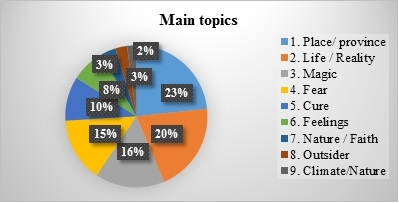
The second film is the comedy “The sun above me never sets” (2019) directed by L. Borisova. The main character of the film is Altan who goes to the Far North after a quarrel with his father. Altan spends a month on a deserted island all alone. Soon he gets a neighbour, an old man called Baibal. Baibal comes there to live last days of his life and asks Altan to bury him next to his wife. One day, the character finds out that Baibal’s daughter disappeared when she was young. He persuades the old man to create an entertaining video blog to find her, and at the same time postpone the day of his death. Altan does everything to encourage the old man to live another beautiful day.
We identified eight main themes in the reviews. Figure 2 presents their ratio.
1) Stages of life:old man, young, generation, guy, new, death / to die, modern, children, woman, elder, grave, to bury, adult, old, young man, teenager, generation gap.
2) Virtues: love, kind, warm, happy / happiness, heart, soulful, worthy, live, sincere / sincerity, light, smile, hope, goodness, wisdom.
3) Family:daughter, family, father, name, grandfather, wife, grandson, uncle, parent, relative, grandmother.
4) Nature: island, North / far North / northern, sea / Laptev Sea, nature, wind, ground, hunt, sky, somewhere far in the forest.
5) Time: summer,time gap, often, eternal, age, always, rare, today, soon, sudden.
6) Seek: to find, to meet / meeting, to lose, together, to gain, search, news.
7) Communication:language / common language, to understand, communication, reply, talk.
8) Technology / Progress: Internet, video blog, channel, globalization, idea, urban.
Figure 2. Topics discussed in the reviews for “The sun above me never sets”
Рисунок 2. Темы, обсуждаемые в рецензиях на фильм «Надо мною солнце не садится»
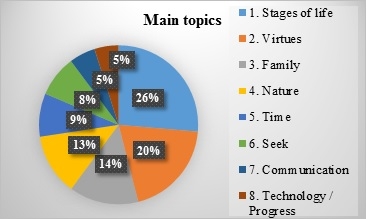
The third film is the drama “Black Snow” (2020) directed by S. Burnashev. This movie is about a long-distance truck driver who delivers food to remote northern areas of Yakutia. He brings vodka to a local illegal alcohol dealer, thereby making the local population booze. After another trip, the main character exchanges vodka (kind of currency among northern population) for meat and fish and decides to go back to the city alone. On his way back, his truck breaks down. While the character is trying to repair the car, it falls down on him, getting him trapped somewhere in the vast wilderness of the north.
Having researched the semantic core of the reviews, we grouped key vocabulary into six semantic fields. Figure 3 illustrates their ratio.
1) Work:way, truck driver, road / to respect the road, city, drive, rout, to sell, price, carcass, cargo, KAMAZ truck, car.
2) Lifestyle: vodka, meat, product, exchange, wolf / lone wolf / wolfish, to get somebody drunk, pain, sick / to be sick, catch, fish, to hunt / hunting.
3) Human nature: sinner / sin, spirit, soul, beast side, businesslike, strong, fair, confident, humane, honest, avaricious, brutal.
4) Climate:snow / snowy, white, survival, winter, frost, fierce.
5) Place:fellow countryman, Yakutia / Yakut, native, village, ethnic, emigrant.
6) Nature:nature, star / polar star, Arctic, affluence, deer, northern lights, severe.
Figure 3. Topics discussed in the reviews for “Black Snow’
Рисунок 3. Темы, обсуждаемые в рецензиях на фильм «Черный снег»
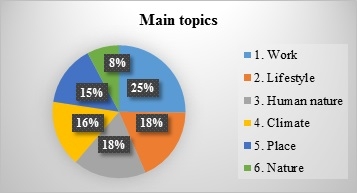
The next film selected for the current study is the detective “My murderer” (2016) directed by K. Marsaan. The film tells a story about a young detective who is investigating a murder. Soon, he finds a suspect who confesses to the crime. It seems that the case can be solved easily but the detective spots oddities and inconsistencies in the testimonies. Despite the disapproval of his chief, the character decides to look into the matter. The chain of events leads him to a settlement of gold miners where he reveals some secrets.
We clustered vocabulary from the semantic core of the reviews into five semantic fields. Figure 4 demonstrates the ratio of these themes.
1) Detective:murder, detective, case, occasion, end, thriller, investigator / investigation / to investigate, criminal, crime, motive, to suspect, police officer, to murder, brutal, intrigue, law, to solve, key, young inspector, clue, chief.
2) Place: republic / Sakha, Russia / Russian, culture / cultural, region / regional, national, city, village, Yakut, dweller, homeland, original, north, tradition, Yakut language, authentic, urban.
3) Nature:nature, North, Asian, wild, lake / Saisary Lake, landscape, mountains, river / the Lena River, taiga, bank, permafrost.
4) Reality: atmosphere, real / real events, world, visible, live, existential / to exist, social, true story, everyday.
5) Gold: gold / golden, mine / gold miner / gold mine.
Figure 4. Topics discussed in the reviews for “My murderer”
Рисунок 4. Темы, обсуждаемые в рецензиях на фильм «Мой убийца»
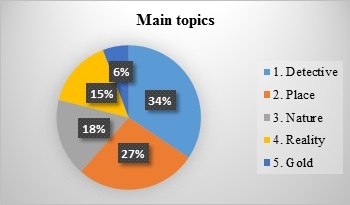
The fifth movie is “His daughter” (2016) directed by T. Everstova. The main character of the film is a first-grade student who lives with her grandparents in a remote village in Yakutia. The girl thinks that the world around her is beautiful, and it will always be like that. She does not want it to change but one day some events happen that the girl is not ready to put up with.
We identified six key themes in the reviews. Figure 5 presents their ratio.
1) Family:grandmother, grandfather, daughter, father, girl, little, close, adult, age, family, granddaughter, child, to be born, relative.
2) Life: tradition, everyday life, language, pace, spirit, soul, custom, household, original.
3) Place:Yakut / Yakutia / Yakutsk, village/ tiny village, taiga, remote, Siberian.
4) Memory: childhood, reminiscence, atmosphere of USSR, memory, past, retelling.
5) Atmosphere: pleasant, sincere, simple, love, careless, tranquility, slow, kind.
6) Nature: nature, world, winter, landscape.
Figure 5. Topics discussed in the reviews for “His daughter”
Рисунок 5. Темы, обсуждаемые в рецензиях на фильм «Его дочь»
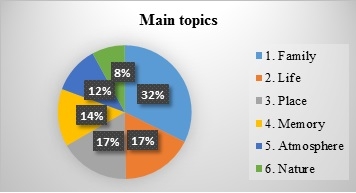
Having compiled semantic fields from lexical units that are included in the semantic cores of the reviews, we received the following results.
Speculation 1. Reviewers insist on a true description of life of the Yakuts by using words like real, reality, realism, social, true story, existential, etc. They claim the films depict everyday life of people without any cinematic embellishments. The lifestyle is traditional, extremely simple and devoid of any frills and pretentiousness. Lexical units like tradition,common, ordinary, everyday, gloomy indicate this. We do not find a single example illustrating people’s wealth or affluence. This quality is only attributed to the nature of Yakutia which is rich in precious metals, gems, fossil fuels.
Film characters are often compared to animals in both their nature and behaviour. For example, we encounter such words and expressions as wolf, lone wolf, wolfish, wild, beast side. They demonstrate that people struggle for their existence in harsh climatic conditions described by numerous adjectives harsh, fierce, severe, etc. The hard work of the inhabitants of Yakut villages is a part of everyday life. Locals are mainly engaged in traditional crafts like fishing, hunting, trade, mining and even witchcraft. Hence, the inference is that life in the Yakut province comes down to survival.
Speculation 2. We distinguish the semantic field “Nature” in reviews for each film. In the discourse of film reviews, we find indications of the geographical location of the republic North, Siberia. There are references to the geographical zones - taiga, which in fact occupies 4/5 of the territory of the region, with its permafrost ground. Besides, we also notice some references to another geographical zone of the region - forest-tundra in the north - owing to expressions like somewherefar in the forest.
It is noteworthy that semantic fields titled “Nature” include vocabulary like bank, river, lake, sea. We believe that it reflects another important natural characteristic of the republic. Yakutia is one of the most riverine territories in Russia since it has 700 thousand rivers and 800 thousand lakes. Yakut cinematic discourse could not do without the image of the Lena River, which is the largest river in the country as well as the outlet of Yakutia to the sea, Laptev Sea.
Special emphasis in the natural description of Yakutia is put on winter. In our opinion, it is not surprising as the season lasts there for as long as six months. Therefore, snow is often mentioned there. Indeed, Yakutia has the coldest permanently inhabited settlements on the planet. We discover that population depends on nature because it feeds them with fish, meat, deer and provides with, for example, gold.
The harsh northern climate, cold, frost, snow, fierce wind determine many aspects of the life of the region. Yakutia is the largest subject of the Russian Federation, but the population density here is one of the lowest in the country. The remoteness of the territory, wild expanses, severe climate and rural landscapes speak of the alienation of people, a detached position in relation to others.
Thus, thanks to the semantic fields “Nature”, built on the basis of semantic kernels of reviews, we get capacious and accurate geographical description of the region pictured in Yakut films. In this regard, we argue that the theme of nature takes the central place in Yakut cinematic discourse. In addition, we believe it also reflects the significance of environment for Yakut folk as well as their strong connection with it.
Speculation 3. Having compiled sematic fields “Place” which include lexical units like village, tiny village, rustic, settlement, hinterland, etc., we realized that mostly rural areas are described in Yakut cinematic discourse. We assume there is a number of reasons for this. Firstly, the number of cities and rural settlements in Yakutia (cf. 13 and 582). Secondly, filmmakers might intend to attract more attention to life of non-urban areas of the region since it is deemed to be more authentic. Through the analysis of semantic cores of the reviews, we deduced that community occupies an important place in life of the Yakut people. A lot of key vocabulary, e.g. surroundings, tradition, culture, cultural, regional, national, custom, ethnic, etc., underline that community is determined by culture and origin. Consequently, Yakut rural community honors its customs, traditions, traditional way of life, respects its roots, and is inevitably connected with the place of origin. People do not stand out there in order have a comfortable live. Otherwise, neighbours will exile them from the community. We have identified the theme “Outsider” in “Scarecrow” where the main character differs from her fellow villagers. It should be noted that the topic of neighbourship is emphasized in the discourse of the reviews, e.g. fellow villager, fellow countryman, neighbour. People who live in small ethnic groups in villages know each other better and rely on each other more than those who live in cities. In case one lives a life of a lone wolf like the main character of “Black snow” then they do not get help when are in troubles.
Speculation 4. Theme of family is identified in the discourse of Yakut cinema as it is discussed in the texts of reviews. The semantic fields titled “Family” contain references to nuclear family comprising mother, father, daughter, wife, parent and extended family comprising grandmother, grandfather, grandson, uncle, etc. This fact indicates the value of affinity and connection not only between parents and their children but also between different relatives and generations. Within this framework topical issues relating to loss of connection with family members and the importance of it restoration are raised. The theme of family addresses to relations between younger and older generations, i.e. generation gap. We notice the possibility of finding a common language for them in the Yakut society.
Speculation 5. Another central theme of the Yakut film discourse is faith. However, not in God. In fact, we do not find any references to God in the texts of reviews. Discourse of the reviews shows that the Yakuts believe in spirits, some ancient magic, power of healing by witchcraft, superstitions, human’s supernatural abilities. Reviewers pay special attention to the ideas of soul and fate (usually bad and ruthless). According to the Yakut traditional ideas, human soul consists of three parts: mother’s soul, earth soul and air soul. Mother’s soul is inherited from parents; it is in traditions, culture. Earth soul is the material substance, or physical body. Air soul is intelligence, mind, communicative and social skills (Kulakovskij, 1975). It seems that these ideas about soul also explain the importance of family bonds and culture for the Yakuts. One more thing we should discuss here that relates to religion is sin. We allocate this keyword into the semantic fields “Faith” and “Human nature”. The fact that this word belongs to the semantic core of the analyzed discourse implies that there are norms and rules in Yakut religion which people do not stick to or break. We find out that there is a word in the modern Yakut language that means transgression, misdemeanor or taboo. This fact appears to prove our assumption.
Speculation 6. Key vocabulary grouped in the semantic fields “Human nature”, “Positive feelings / features”, “Feelings” demonstrate that human nature of the Yakuts is dual. On the one hand, there are many confirmations of its depravity, sinfulness, greed, e.g. spite, spiteful, avaricious, sinner, to hate, beast side, etc. On the other hand, kindness, sincerity, honesty,dedication illustrate its virtues. We found out that in Yakut mythology a person is defined as a very different, multi-faceted, contradictory, and ambivalent being. A person can be both old and young, good and evil, angel and devil, beautiful and ugly, brave and cowardly. Every time human beings are characterized differently because they have a diverse set of properties. Thus, film characters balance between good and evil. Meanwhile, we observe that good is often rewarded with evil. This fact speaks about the injustice of destiny again. According to the cosmogony of the traditional religion of the Yakuts, the world exists in three dimensions: the underworld inhabited with evil spirits; the middle world where people live; the upper world which is the abode of the supreme deities (Novikov 1996). The curious thing is that supreme deities are not always good. We suppose that this fact can explain life unfairness for the Yakuts.
Speculation 7. Through the film reviews discourse we learn about the problems which affect life of the Yakut society. The results of the analysis demonstrated that one of the vices or weaknesses of the Yakuts is alcohol. We included the key word vodka into the semantic field “life” as it is described as a part of everyday routine. Alcohol helps people to escape from the harsh reality, hard work, and fear of bleak future. In addition to drinking, the characters of the Yakut cinematic discourse suffer from loneliness. Perhaps, the first is the consequence of the second. In our opinion, the reasons for loneliness can be internal and / or external. To internal ones we refer oddities of characters’ behaviour. If a member of the ethnic community differs from the others then he/she will become an outcast. We believe that external causes of loneliness are remoteness of settlements, long distances that characters have to travel between them, vastness of the territory, low population density. It seems that the reviewers draw a parallel between isolation of the republic and the feeling of loneliness of its residents. The isolation of people living in the hinterland leads to another problem - technological backwardness - discussed in the reviews. In general, we infer that the republic is not much involved in the process of globalization.
The results of the content analysis demonstrate that modern Yakut cinematic discourse sheds the light on the life and character of the Yakuts. Depicting the characters’ inner world and emotional experience, the cinematic discourse inevitably increases its emotivity. According to Shakhovsky, emotion is an additional content of an utterance as well as a way to assess the meaning of objects and phenomena of the real world (Shakhovsky, 2008). As a rule, film reviews as secondary texts include three emotive components: description of characters’ emotions, viewer’s emotions evoked by the film, and reviewer’s emotional reaction to the movie which is entwined with the assessment. It is important to note that only three out of 72 reviews analyzed in this paper have negative rating. Thus, through the analysis of the film reviews’ sentiment (emotions) we will discover the additional content of the films conveyed via secondary texts. We suppose that the sentiment analysis of the reviews will complement the results of the content analysis as well as provide other features of the Yakut cinematic discourse.
2. Sentiment analysis
Technological approaches to setting and classifying tone of a text differ (e.g. rule-based, dictionary-based, machine learning, etc.) but in the case of SentiStrength the method of tonal dictionaries is used. A tonal dictionary is a list of words with a key value for each word, i.e. a figure with a plus or minus sign. Analyzing a text, the program finds words that are contained in the dictionary, assigns them the appropriate tone values, and then calculates the tone of the whole text. The algorithm for implementing a sentimental analysis of the film reviews and presenting its results included the following steps: analysis of each review by means of the program, identifying its positive and / or negative value, calculation of total negative or positive figures for each film, and presenting the results in form of a graph. Figure 6 and Figure 7 demonstrate the results of the sentiment analysis.
Figure 6. Sentiment analysis of the critics’ reviews
Рисунок 6. Сентимент-анализ рецензий критиков
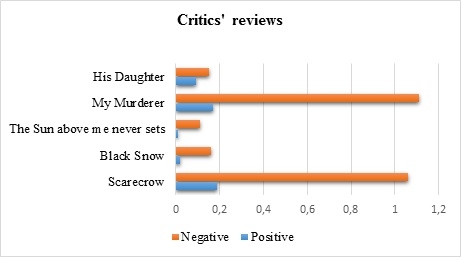
Figure 7. Sentiment analysis of the users’ reviews
Рисунок 7. Сентимент-анализ рецензий пользователей
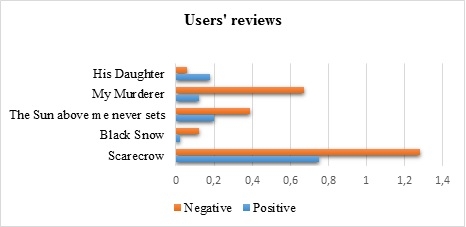
Observation 1. The figures show the film “Scarecrow” seems to the viewers not as gloomy as to the critics. We see that the positive figure is almost by 40% lower than the negative one for users’ reviews. Meanwhile, for critics’ reviews this figure is by 75% lower.
Observation 2. The results of the sentiment analysis of critics’ and users’ reviews for “Black snow” demonstrate approximately the same ratio of positive and negative figures. Nevertheless, the negative value of users’ reviews is by 50% lower than of critics’.
Observation 3. We obtained curious results for the film “The sun above me never sets”. The negative value of users’ reviews is by 50% higher than the positive one. As for the critics’ reviews, negative sentiments are four times lower than for users’, and positive are hardly evidenced for them.
Observation 4. Positive figures are approximately the same for both critics’ and users’ reviews for the detective story “My murderer”. However, negative value is almost twice as high for critics (54% higher).
Observation 5. The users’ reviews for “His daughter” are the only reviews which have positive value higher than negative one. Positive figure is by 25% higher there. On the contrary, critics’ reviews have negative sentiments twice as high as positive ones.
Observation 6. 16,1% of critics’ reviews turned out to have 0 sentiment value. As for users’ reviews, 10,2% of them are neutral. 35,4 % of critics’ reviews have only negative value. In contrast, 20,5 % of users’ reviews have only negative value. 6,4 % of critics’ reviews have only positive value compared to 12,8 % of users’ reviews.
The results of the analysis show the apparent difference between sentiments of critics’ and users’ reviews. We assume that this difference may be explained by the following factors. First, polar sentiments expressed by most of the critics’ and users’ reviews for the film “His daughter” may be caused by the divergence in perception of the film story. In our view, ordinary viewers may identify themselves with movie characters and associate characters’ lives, problems, worries, with their own. Consequently, being sympathetic with the characters, the users are likely to describe the story and their own emotions in a more positive way. Critics on their part presumably try to stay objective and do not built such associations. Second, the extent to which negative sentiments prevail over positive ones in the critics’ reviews unlike in users’ texts may stem from the difference in verbalization of emotions. The critics allegedly resort to more emotional and expressive vocabulary in their texts to influence the reader. Thus, their reviews acquire much higher negative value. Whereas the users tend to focus not on the consumption of their texts but on the description of their own understanding, perception, assessment of a film. Hence, critics and users may have different writing styles which result in different sentiment values of their reviews. We admit the overall negative sentiment of the reviews and attribute it to the Yakut cinematic discourse.
We also carried out a phonosemantic analysis of the texts to specify what tones positive and negative sentiments of the reviews correlate with. We applied VAAL, a Russian application created for qualitative and quantitative analysis of sound components of a word, utterance or text (Ivanova, Soboleva, 2020). According to Studentsova and Golomzik, the application allows to predict the effect of the unconscious impact of texts and single words, based on their phonosemantic characteristics, on the mass audience (Studentsova, Golomzik, 2013).
We conducted the phonosemantic analysis of each film review and identified the most frequent tone characteristics of these texts.
“Scarecrow”: majestic, strong, loud, bright, repulsive, scary, angry, great, brave.
“The sun above me never sets”: angry, slow, frail, great, brave, scary, cowardly.
“Black snow”: angry, masculine, strong, scary, rough, slow, bad, heavy, cold, dark.
“My murderer”: cheerful, angry, small, weak, quiet, frail, rough, cowardly, dull, scary, sad, base.
“His daughter”: small, rough, repulsive, bad, angry, scary, quiet, cowardly, dull, frail.
The obtained results illustrate that paramount tones of all reviews are angry and scary. In fact, these tone characteristics are consistent with the overall negative sentiment of the reviews. Although negative tones dominate over positive ones, we can put them in antagonistic pairs. For example, angry / scary / sad - cheerful, strong - frail, cowardly - brave, quiet - loud, bright - dull, repulsive - majestic. We notice the similarity between the tonality dualism and ambiguity of human nature distinguished through the content analysis of the reviews. Thus, we can extrapolate this quality of ambivalence onto the Yakut cinematic discourse. In general, the tones of the reviews indicate gloomy atmosphere created by the film stories. Having identified the main themes of the Yakut cinematic discourse, we can attribute the tone characteristics to particular content items. Thus, we suppose that the Yakut cinematic discourse depicts miserable life full of hardships and unfairness in harsh climatic conditions of disadvantaged people who are brave and coward, weak and strong at the same time. We conclude that the main themes of the Yakut cinematic discourse have and evoke negative sentiment accompanied with angry and scary tonality.
Conclusion
The current study demonstrated that a comprehensive analysis of cinematic discourse can be carried out through investigation of secondary texts. This paper considers a film review for this purpose. The results of the research showed that by means of computer-mediated content analysis we obtained the data about the main themes of cinematic discourse of the ethnic minority, e.g. everyday life of the Yakut people, nature of the republic, non-urban community, social issues, family relations, fate. The tools of sentiment and phonosemantic analysis prove to be efficient for studying sentiments of the movie content and its perception by viewers. Through the film reviews analysis we discovered that the Yakut cinematic discourse has overall negative sentiment along with angry and scary tone. The findings of the current study suggest that there is a possibility to research a specific cinematic discourse of either ethnic or mainstream movies through secondary texts and discourse in order to discover its particular features.
[1] Iampolski, M. (2012). Chto takoe kinokritika? [What is film criticism?], OpenSpace.ru, available at: http://os.colta.ru/cinema/events/details/35533?expand= yes#expand (Accessed 13.08.2021). (In Russian)
[2]Kinopoisk, available at: https://www.kinopoisk.ru/ (Accessed 20.01.2022). (In Russian)
[3] Gazeta.ru, available at: https://www.gazeta.ru/ (Accessed 25.01.2022). (In Russian)
[4] Fontanka, available at: https://www.fontanka.ru/ (Accessed 25.01.2022). (In Russian)
[5] Kinoart, available at: https://kinoart.ru/ (Accessed 25.01.2022). (In Russian)
[6] Kino-teatr.ru, available at: https://www.kino-teatr.ru/ (Accessed 26.01.2022). (In Russian)
[7] GQ, available at: https://www.gq.ru/ (Accessed 26.01.2022). (In Russian)
[8] Kinoafisha, available at: https://www.kinoafisha.info/ (Accessed 26.01.2022). (In Russian)
[9] InterMedia, available at: http://www.intermedia.ru/ (Accessed 28.01.2022). (In Russian)
[10] Buro 24/7, available at: https://www.buro247.ru/ (Accessed 28.01.2022). (In Russian)
[11] Expert, available at: https://expert.ru/ (Accessed 28.01.2022). (In Russian)
[12]Trud, available at: https://www.trud.ru/ (Accessed 28.01.2022). (In Russian)
[13] Time Out, available at: https://www.timeout.ru/msk (Accessed 28.01.2022). (In Russian)
[14] Meduza*, available at: https://meduza.io/ (Accessed 28.01.2022). (In Russian) (*is included by the Ministry of Justice of the Russian Federation in the register of foreign media performing the functions of a foreign agent)
[15] Echo of Moscow, available at: https://echo.msk.ru/ (Accessed 28.01.2022). (In Russian)
[16] Bolshoi psikhologicheskii slovar [The big physiological dictionary]. Ed. by B. Meshcheryakov, V. Zinchenko. Moscow: Praim-Evroznak : OLMA-PRESS, 2005. (In Russian)
[17] ADVEGO, available at: https://advego.com/text/seo/ (Accessed 30.01.2022).
[18] SentiStrength, available at: http://sentistrength.wlv.ac.uk/ (Accessed 10.02.2022).
[19] VAAL, available at: http://www.vaal.ru/prog/free.php (Accessed 10.02.2022).


















Список литературы
Список использованной литературы появится позже.